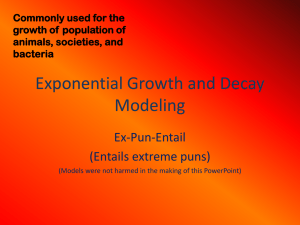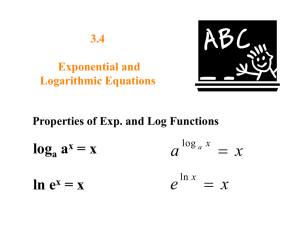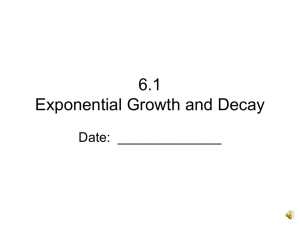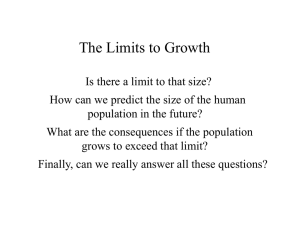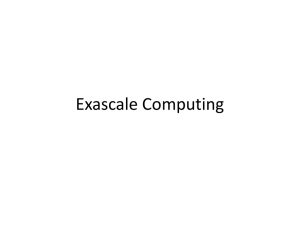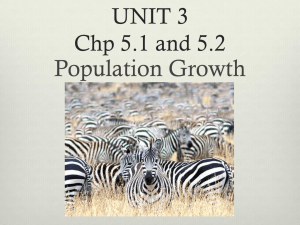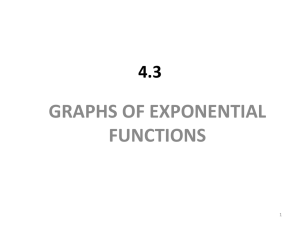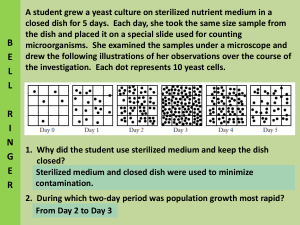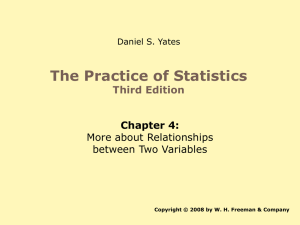Powerpoint Section 4.1 B
advertisement
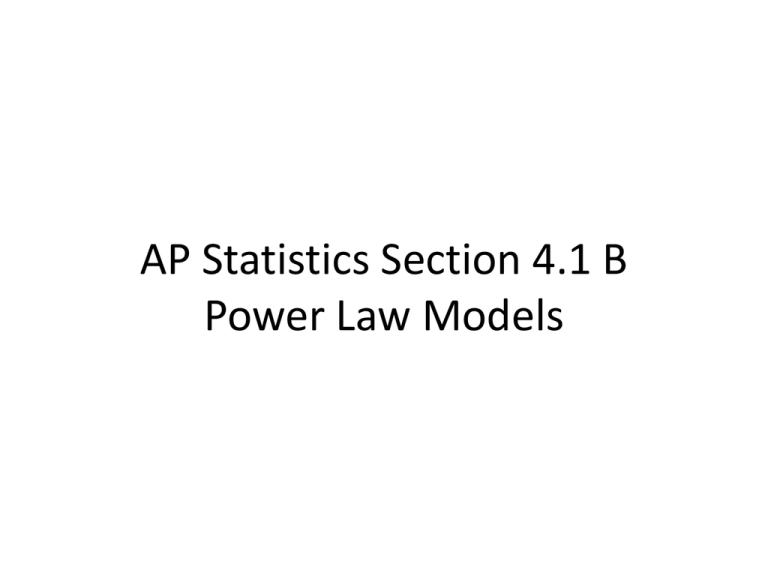
AP Statistics Section 4.1 B Power Law Models Exponential growth occurs when a variable is multiplied by a fixed number in each equal time period. In other words, exponential growth increases by a fixed percent of the previous total in each equal time period. Example 2: You won a lottery. You have a choice of (a) getting $100,000 each day for the month of November or (b) getting $0.01 on November 1st, $0.02 on November 2nd, $0.04 on November 3rd, etc until November 30th. What is your choice? For choice (a), at the end of the month you would have 30 100000 $ 3 , 000 , 000 For choice (b), you would have p (1 r ) t . 01 (1 1) 30 $ 10 , 737 , 418 . 24 This example illustrates the power of exponential growth. Example 3: Here is the number of bacteria present after a given number of hours. Graph the data. The curve is increasing exponentially. How can we tell if an exponential model is appropriate? For equal increments in x, calculate the ratio of a y-value divided by the previous y-value. All such ratios should be equal for a perfectly exponential function. 2 .4 1 .8 1. 3 3.1 2.4 1 . 29 4.3 3.1 1 . 39 Exponential growth can be modeled by the equation x ________, y a b where a and b are constants. To help us “straighten” this model we will use a logarithm transformation. Take the ln of both sides. ln y ln( a b ) x The ln of a product equals the sum of the ln’s . ln y ln a ln b ) x The ln of a power equals the power times the ln. ln y ln a x ln b ) Notice that this form is the equation of a line. For a logarithmic transformation we will take the log of the y-values and leave the x-values alone. Graph hours (x) in L1 vs. ln y in L3. Calculate the LSL on the transformed points and construct a residual plot to verify the validity of our model. ln(# bacteria ) . 0047 . 5860 (# hours ) Determine r2 and interpret it in the context of the problem. r . 999 2 99.9% of the variation in the natural log of the number of bacteria is accounted for by the linear relationship with the number of hours Interpret the slope and y-intercept in the context of the problem. The slope tells us that an increase in one hour will cause an increase of .5860 in the natural log of the number of bacteria. The y-intercept tell us that at hour 0, the natural log of the number of bacteria will be -.0047 Solve the LSL for yˆ and predict how many bacteria will be present at 3.75 hours. ln yˆ . 0047 . 5860 x yˆ e yˆ e . 0047 . 5860 x . 0047 yˆ 8 . 96 e . 5860 x Example 4: In 1965, Gordon Moore, a founder of Intel Corp., predicted that the number of transistors in an integrated circuit chip would double every 18 months (i.e exponential growth). Here is some data from a stats package that was run on the data of the number of transistors versus time since 1970. The data was straightened out by using a logarithmic transformation on the number of transistors. x = # of years since 1970, y = ln (transistors). We use “years since” so that the values are smaller and don’t create overflow problems with the calculator. Predictor Coef Constant 7.4078 Yrs since1970 0.3316 R-Sq = 99.5% Write the LSL. ln(# transistor s) 7 . 4078 . 3316 ( years since 1970) 2 Interpret r in context. 99.5% of the variation in ln(#transistors) is accounted for by the linear relationship with the # of years since 1970. Predict the number of transistors in the year 2003. yˆ e 7 . 4078 . 3316 ( 33 ) yˆ 93 , 231 ,853 . 78
